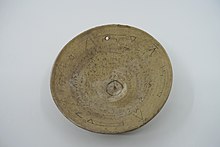
Back اللغة المندائية Arabic لغه مندائيه ARZ Idioma mandeo AST Mandaeg klasel Breton Llengua mandea Catalan زمانی مەندایی CKB Mandäische Sprache German Mandaja lingvo Esperanto Idioma mandeo Spanish زبان مندایی Persian
| Mandaic | |
|---|---|
| ࡋࡉࡔࡀࡍࡀ ࡖ ࡌࡀࡍࡃࡀࡉࡉࡀ Lishāna’d Mandāyì | |
| Native to | Iraq and Iran |
| Region | Iraq – Baghdad, Basra Iran – Khuzistan |
| Ethnicity | Mandaeans |
Native speakers | 5,500 (2001–2006)[1] |
Early forms | |
| Mandaic alphabet | |
| Language codes | |
| ISO 639-3 | Either:mid – Mandaicmyz – Classical Mandaic |
mid Neo-Mandaic | |
myz Classical Mandaic | |
| Glottolog | mand1468nucl1706clas1253 |
 Mandaic is classified as Critically Endangered by the UNESCO Atlas of the World's Languages in Danger (2010)[2] | |

Mandaic, or more specifically Classical Mandaic, is the liturgical language of Mandaeism and a South Eastern Aramaic variety in use by the Mandaean community, traditionally based in southern parts of Iraq and southwest Iran, for their religious books. Mandaic, or Classical Mandaic is still used by Mandaean priests in liturgical rites.[3] The modern descendant of Mandaic or Classical Mandaic, known as Neo-Mandaic or Modern Mandaic, is spoken by a small group of Mandaeans around Ahvaz[4]: XXXVI–XXXVIII, 1–101 and Khorramshahr[5] in the southern Iranian Khuzestan province.
Liturgical use of Mandaic or Classical Mandaic is found in Iran (particularly the southern portions of the country), in Baghdad, Iraq and in the diaspora (particularly in the United States, Sweden, Australia and Germany). It is an Eastern Aramaic language notable for its abundant use of vowel letters (mater lectionis with aleph, he only in final position, ‘ayin, waw, yud) in writing, so-called plene spelling (Mandaic alphabet)[6] and the amount of Iranian[7] and Akkadian[8] language influence on its lexicon, especially in the area of religious and mystical terminology. Mandaic is influenced by Jewish Palestinian Aramaic, Samaritan Aramaic, Hebrew, Greek, Latin,[9][10] in addition to Akkadian[8] and Parthian.[11]
- ^ Mandaic at Ethnologue (18th ed., 2015) (subscription required)
Classical Mandaic at Ethnologue (18th ed., 2015) (subscription required) - ^ "Atlas of the world's languages in danger". unesdoc.unesco.org. p. 42. Retrieved 2023-03-02.
- ^ Ethel Stefana Drower, The Mandaeans of Iraq and Iran (Leiden: Brill, 1937; reprint 1962); Kurt Rudolph, Die Mandäer II. Der Kult (Vandenhoeck & Ruprecht; Göttingen, 1961; Kurt Rudolph, Mandaeans (Leiden: Brill, 1967); Christa Müller-Kessler, Sacred Meals and Rituals of the Mandaeans”, in David Hellholm, Dieter Sänger (eds.), Sacred Meal, Communal Meal, Table Fellowship, and the Eucharist: Late Antiquity, Early Judaism, and Early Christianity, Vol. 3 (Tübingen: Mohr, 2017), pp. 1715–1726, pls.
- ^ Cite error: The named reference
Macuch 1993was invoked but never defined (see the help page). - ^ Cite error: The named reference
Haberl 2009was invoked but never defined (see the help page). - ^ Theodor Nöldeke, Mandäische Grammatik (Halle: Waisenhaus, 1875), pp. 3–8.
- ^ No comprehensive and individual study exists yet except for some word discussions in Geo Widengren, Iranisch-semitische Kulturbegegnung in parthischer Zeit (Köln: Westdeutscher Verlag, 1960) and the etymological sections in Ethel Stefana Drower and Rudolf Macuch, A Mandaic Dictionary (Oxford: Clarendon Press, 1963).
- ^ a b Stephen A. Kaufman, The Akkadian Influences on Aramaic (Assyriological Studies 19; Chicago: The University of Chicago: 1974).
- ^ Häberl, Charles (3 March 2021), "Hebraisms in Mandaic", YouTube, retrieved 25 April 2022
- ^ Häberl, Charles (2021). "Mandaic and the Palestinian Question". Journal of the American Oriental Society. 141 (1): 171–184. doi:10.7817/jameroriesoci.141.1.0171. ISSN 0003-0279. S2CID 234204741.
- ^ Häberl, Charles G. (February 2006). "Iranian Scripts for Aramaic Languages: The Origin of the Mandaic Script". Bulletin of the American Schools of Oriental Research (341): 53–62. doi:10.7282/T37D2SGZ.
© MMXXIII Rich X Search. We shall prevail. All rights reserved. Rich X Search